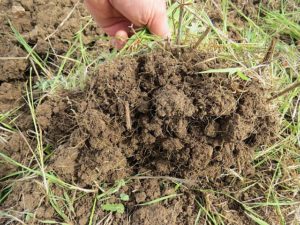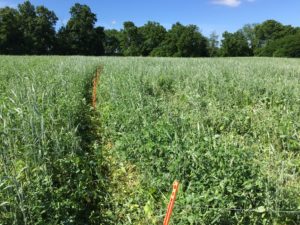Building Healthy Pasture Soils
Focus on biology to build resilient soils that sustain production and deliver profitable yields with reduced inputs.
Soil fertility in pastures goes well beyond a simple discussion of soil samples, fertilizers, and the nutrients needed to produce high yields. Rather, soil health is an ecosystem concept: it is holistic and complex, and involves regenerative, adaptive management. Managing grazing and harnessing the inherent abilities of living, healthy soil can promote productive pastures and animals.
With this type of management, we are observational and not reactive: we are looking at soil indicators such as aggregation, species diversity, and cover. We are looking for telltale signs of soil ill-health, such as run-off, compaction, and bare ground. Within a regenerative system, we are interested in the fundamentals: what drives the whole system. Soil microorganisms need to be fed with a constant diet of carbon from the sun. These microbes need habitat and a balanced diet, and this is accomplished through plant diversity, living roots, and soil cover all year. The saying ‘build it and they will come’ applies here, and if we make sure the microbes are fed, they will do the work of building soil health and fertility for us.
Let’s consider the farming practices that feed soil microbes and help build healthy soil. In essence, we want to increase aggregation, contribute soil organic matter, increase biodiversity, buffer soil temperature, and minimize soil compaction and disturbance. Sounds like a lot, right? Well, not really, if we break these objectives down into some basic principles. Let’s take a quick look at the principles that will define our pasture soil management practices.

Soils that are well aggregated with adequate organic matter are resilient and can sustain crops with minimal input. Credit – Robyn Metzger, NCAT
Minimizing tillage preserves soil structure, encourages aggregation, and keeps soil carbon in the soil profile where it belongs. Tillage brings a flush of oxygen into the soil that spurs microbes into a feeding frenzy on carbon molecules, resulting in carbon dioxide release. We reduce tillage through the use of perennial pasture and minimum-tillage, or no-till, cover crops.
Maintaining living roots in the soil for as much of the year as possible feeds soil microorganisms all year. Also, by maintaining living roots and leaving grazing residual, we cover the soil all year long, forming an “armor” to protect the soil from moisture and nutrient loss.
Maintaining species diversity is achieved with cover crop mixes and the use of diverse perennial pasture mixes. Try to incorporate warm season and cool season plants; it is a good idea to plant both grasses and broadleaf plants in the same fields.
Manage grazing by planning for an appropriate grazing recovery period on your paddocks, keeping in mind that plants need various recovery periods depending on the species, the time of year, and the soil moisture content. Overgrazing (not allowing adequate recovery) reduces root mass, photosynthesis, and sequestered carbon in the soil, thereby decreasing soil life. Proper grazing builds soil.
Finally, put animal and grazing impact to work for you. Livestock provides nutrient cycling in pastures, contributing to soil organic matter, and the grazing action on forage plants encourages root growth and root exudation of plant sugars that feed soil microorganisms.
For livestock producers, this boils down to a combination of perennial pasture, cover crops in rotation, and good grazing management. Perennial pastures, because of the lack of soil disturbance and permanent cover, are higher in carbon and organic matter than tilled crop fields. This biological system has a stable habitat to conduct business, and the nutrient cycles can sustain themselves. However, by adding livestock, we get a multiplier effect on soil health, even in systems that are cropped with a cash crop as part of the rotation.
Grazing is known to increase soil carbon and nitrogen in the soil. As an animal grazes, it sends a signal to the plant to pump out sugars through its roots into the surrounding soil. These root exudates, sugars developed by the plant through photosynthesis, are food sources for the microorganisms in the soil. The action of grazing jump-starts the soil food web and increases nutrient cycling, making nutrients available to plants.

Diverse cover crops build soil health while providing high quality forage for grazing livestock. Credit – Lee Rinehart, NCAT
Cover crops are known to benefit the soil by feeding soil life, buffering temperatures, and increasing water efficiency. Many crop farmers are familiar with cover crops, but with livestock and cover crops in combination, you have all the tools you need to build soil health. Grazing is often the missing link for crop farmers. By putting animals on cover crops you can close the loop and develop a more resilient system.
Think of livestock as biological “roller-crimpers,” or cover crop terminators. Combining the below-ground effects of grazing on root exudates with the biological contribution from animals far exceeds the benefits of cover crops alone. Because the microbes in the rumen are similar to the microbes in the soil, ruminant animals prime the soil with biological life, contributing to the health of the soil.
If you’re a farmer who has a predominately cash-crop-oriented income, it may be attractive to graze cover crops in rotation with cash crops. Annual crops can be rotated to perennial pasture every few years. You can also incorporate grazing of cover crops in a strictly cash crop system, as Gabe Brown has demonstrated. His fall biennial crop > warm season cover crop > fall biennial crop > cash crop rotation works well in his system. In this system, you only have one year off from cash crop, but you get three cover crops incorporated, all grazed. This cover crop sequence works very well to “prime” depleted soils.
Managed Grazing Tutorial
Interested in finding out more about how managing your livestock can improve your soil health, your pasture condition, and your bottom line? The ATTRA Managed Grazing tutorial features sessions taught by ATTRA specialists who are also livestock producers. They share years of experience managing their own pastures to inspire you to start wherever you are and build or refine your own managed grazing systems. The tutorial includes detailed presentations and real-world examples including conducting a forage inventory, fencing and water, managing the mature stand, intensifying managed grazing, stockpiling grass, managing fertility, and monitoring. Access the Managed Grazing tutorial free online at ATTRA.
It seems like there is a lot involved in managing pasture fertility holistically… and there is. The biological processes are complex and they interrelate with weather, moisture, season, crop selection, and livestock. Even soil scientists do not understand everything that goes on in the soil, but we do have a pretty good idea of the processes, and we know that biology is the basis for soil function. We also know that energy drives the whole system.
Transitioning to a biological system from a chemical system is a slow process, and it’s important to recognize that it will take several years for soils to turn around. Be patient, and as Ray Archuleta, a soils conservationist with NRCS, says, “Have the integrity to believe that nature will work with you over time, that it’s going to work.” This is important, because there are going to be some problems that crop up. It could be anything from decreased weaning weights on calves, to weed problems, to livestock parasites. Expect these problems to occur, because you’re dealing with a biological system that is trying to get back into balance. Don’t jump ship at the first obstacle and succumb to the temptation to revert to an input-based system. Resilience and the integrity to stay focused will pay off in the years to come as the biology builds to the point of sustainability.
So, how do you get started? Remember the three practices we spoke of earlier: perennial pasture, cover crops, and grazing management. These practices build soil carbon, which is the key to fostering soil health and plant fertility. Making the transition takes time and attention, but the benefits are long term. Think of it as an investment in your soil, just like you invest in livestock and equipment. And as you begin this journey of renewal, remember that it’s a biological system that is fully dependent on the almost incomprehensible diversity of life and life processes that happen unseen, among the roots just under the soil surface.
It took decades for your soil to degenerate, so expect several years for your farm to recover. Don’t make the mistake of expecting to reverse the tide in one year. As you transition, keep in mind the following concepts: when you feed soil microbes, you feed the plant—productivity is based on the relationships between plants, soil, and animals. The process of nutrient transfer is kept strong by adding organic matter. Reduce your off-farm inputs to reduce cost, and transition slowly. Have integrity that it will work by staying the course even when the system seems to crash. Observe and adapt. And if your soil is low in carbon, don’t expect it to work. To fix it, start by putting in one or two years of cover crops and graze it appropriately to get the system primed. You might be surprised by the results.
Managing for carbon by keeping soils covered with growing plants and with managed defoliation through grazing, builds the organic matter that provides the fertility pastures need to be productive.
For more information: The ATTRA program has served as the premier source of information about sustainable agriculture for U.S. farmers and other agriculturists for more than twenty years. Visit the ATTRA website at https://attra.ncat.org/.
This article has been adapted from a forthcoming ATTRA publication entitled Building Healthy Pasture Soils, by Lee Rinehart.


I am still in the learning phase of healthy pastures and your article was interesting, especially the information that grazing is part of pasture health, if done correctly.
A comprehensive overview. Transitioning to holistic soil management indeed demands patience and dedication but the long term benefits for soil health and productivity are invaluable.
Taxi Services to Montreal Airport